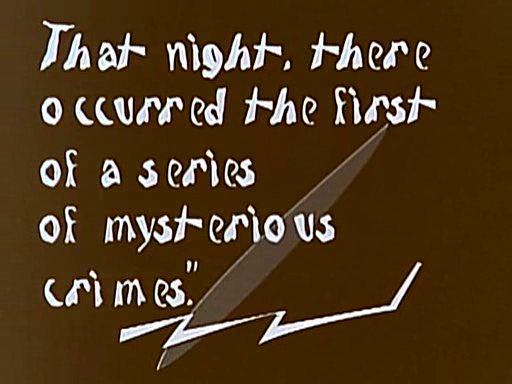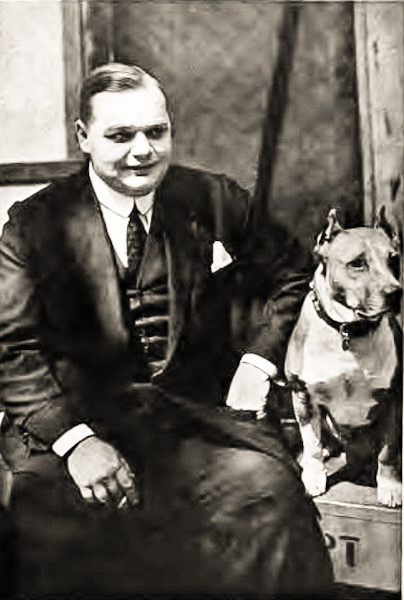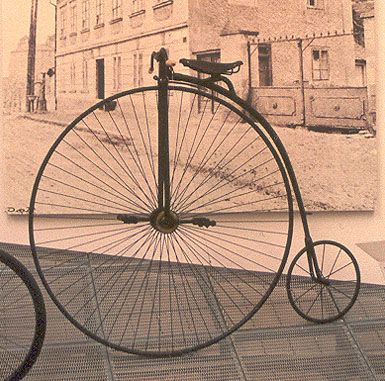|
Once Upon A Time (The Twilight Zone)
"Once Upon a Time" is episode 78 of the American television anthology series ''The Twilight Zone''. It originally aired on December 15, 1961. It features early film star Buster Keaton in one of his later roles, as an unlikely time traveler, and the opening and closing scenes pay tribute to the silent films for which he was famous. Opening narration Plot Woodrow Mulligan is a grumpy man in 1890, dissatisfied with what his world has come to: the nation's budget surplus is only 85 million dollars, prices are shockingly high to him, and his once-quiet town of Harmony, New York is bustling with livestock roaming the streets, which are full of horse-drawn carriages and penny-farthing bicycles moving at the speed limit of 8 mph. A collision with a bicyclist dumps him in a water trough, forcing him to take off his pants to dry them when he gets to his place of work. He works as janitor for Professor Gilbert, who has just invented a "time helmet", which can transport the wearer to a ... [...More Info...] [...Related Items...] OR: [Wikipedia] [Google] [Baidu] |
The Twilight Zone (1959 TV Series)
''The Twilight Zone'' (marketed as ''Twilight Zone'' for its final two seasons) is an American science fiction horror anthology television series created and presented by Rod Serling, which ran for five seasons on CBS from October 2, 1959, to June 19, 1964. Each episode presents a stand-alone story in which characters find themselves dealing with often disturbing or unusual events, an experience described as entering "the Twilight Zone," often with a surprise ending and a moral. Although predominantly science-fiction, the show's paranormal and Kafkaesque events leaned the show towards fantasy and horror. The phrase "twilight zone," inspired by the series, is used to describe surreal experiences. The series featured both established stars and younger actors who would become much better known later. Serling served as executive producer and head writer; he wrote or co-wrote 92 of the show's 156 episodes. He was also the show's host and narrator, delivering monologues at the begi ... [...More Info...] [...Related Items...] OR: [Wikipedia] [Google] [Baidu] |
Silent Film
A silent film is a film with no synchronized recorded sound (or more generally, no audible dialogue). Though silent films convey narrative and emotion visually, various plot elements (such as a setting or era) or key lines of dialogue may, when necessary, be conveyed by the use of title cards. The term "silent film" is something of a misnomer, as these films were almost always accompanied by live sounds. During the silent era that existed from the mid-1890s to the late 1920s, a pianist, theater organist—or even, in large cities, a small orchestra—would often play music to accompany the films. Pianists and organists would play either from sheet music, or improvisation. Sometimes a person would even narrate the inter-title cards for the audience. Though at the time the technology to synchronize sound with the film did not exist, music was seen as an essential part of the viewing experience. "Silent film" is typically used as a historical term to describe an era of cinema pri ... [...More Info...] [...Related Items...] OR: [Wikipedia] [Google] [Baidu] |
Television Episodes Written By Richard Matheson
Television, sometimes shortened to TV, is a telecommunication medium for transmitting moving images and sound. The term can refer to a television set, or the medium of television transmission. Television is a mass medium for advertising, entertainment, news, and sports. Television became available in crude experimental forms in the late 1920s, but only after several years of further development was the new technology marketed to consumers. After World War II, an improved form of black-and-white television broadcasting became popular in the United Kingdom and the United States, and television sets became commonplace in homes, businesses, and institutions. During the 1950s, television was the primary medium for influencing public opinion.Diggs-Brown, Barbara (2011''Strategic Public Relations: Audience Focused Practice''p. 48 In the mid-1960s, color broadcasting was introduced in the U.S. and most other developed countries. The availability of various types of archival stora ... [...More Info...] [...Related Items...] OR: [Wikipedia] [Google] [Baidu] |
Television Episodes About Time Travel
Television, sometimes shortened to TV, is a telecommunication medium for transmitting moving images and sound. The term can refer to a television set, or the medium of television transmission. Television is a mass medium for advertising, entertainment, news, and sports. Television became available in crude experimental forms in the late 1920s, but only after several years of further development was the new technology marketed to consumers. After World War II, an improved form of black-and-white television broadcasting became popular in the United Kingdom and the United States, and television sets became commonplace in homes, businesses, and institutions. During the 1950s, television was the primary medium for influencing public opinion.Diggs-Brown, Barbara (2011''Strategic Public Relations: Audience Focused Practice''p. 48 In the mid-1960s, color broadcasting was introduced in the U.S. and most other developed countries. The availability of various types of archival storag ... [...More Info...] [...Related Items...] OR: [Wikipedia] [Google] [Baidu] |
The Twilight Zone (1959 TV Series Season 3) Episodes
''The Twilight Zone'' is an American media franchise based on the anthology television series created by Rod Serling. The episodes are in various genres, including fantasy, science fiction, absurdism, dystopian fiction, suspense, horror, supernatural drama, black comedy, and psychological thriller, often concluding with a macabre or unexpected twist, and usually with a moral. A popular and critical success, it introduced many Americans to common science fiction and fantasy tropes. The first series, shot entirely in black and white, ran on CBS for five seasons from 1959 to 1964. ''The Twilight Zone'' followed in the tradition of earlier television shows such as ''Tales of Tomorrow'' (1951–53) and ''Science Fiction Theatre'' (1955–57); radio programs such as ''The Weird Circle'' (1943–45), '' Dimension X'' (1950–51) and ''X Minus One'' (1955–58); and the radio work of one of Serling's inspirations, Norman Corwin. The success of the series led to a feature film (1 ... [...More Info...] [...Related Items...] OR: [Wikipedia] [Google] [Baidu] |
1961 American Television Episodes
Events January * January 3 ** United States President Dwight D. Eisenhower announces that the United States has severed diplomatic and consular relations with Cuba (Cuba–United States relations are restored in 2015). ** Aero Flight 311 (Koivulahti air disaster): Douglas DC-3C OH-LCC of Finnish airline Aero crashes near Kvevlax (Koivulahti), on approach to Vaasa Airport in Finland, killing all 25 on board, due to pilot error: an investigation finds that the captain and first officer were both exhausted for lack of sleep, and had consumed excessive amounts of alcohol at the time of the crash. It remains the deadliest air disaster to occur in the country. * January 5 ** Italian sculptor Alfredo Fioravanti marches into the U.S. Consulate in Rome, and confesses that he was part of the team that forged the Etruscan terracotta warriors in the Metropolitan Museum of Art. ** After the 1960 military coup, General Cemal Gürsel forms the new government of Turkey (25th government). ... [...More Info...] [...Related Items...] OR: [Wikipedia] [Google] [Baidu] |
Running Gag
A running gag, or running joke, is a literary device that takes the form of an amusing joke or a comical reference and appears repeatedly throughout a work of literature or other form of storytelling. Though they are similar, catchphrases are not considered to be running gags. Running gags can begin with an instance of unintentional humor that is repeated in variations as the joke grows familiar and audiences anticipate reappearances of the gag. The humor in a running gag may derive entirely from how often it is repeated, but the underlying statement or situation will always be some form of joke. A trivial statement will not become a running gag simply by being repeated. A running gag may also derive its humor from the (in)appropriateness of the situation in which it occurs, or by setting up the audience to expect another occurrence of the joke and then substituting something else (''bait and switch''). Running gags are found in everyday life, live theater, live comedy, television ... [...More Info...] [...Related Items...] OR: [Wikipedia] [Google] [Baidu] |
Ray Turner (pianist)
Raymond (Ray) Turner (15 March 1903, Kenosha, Wisconsin - February 1976, Hollywood, California) was an American pianist, session musician and recording artist. Biography The classically-trained Turner, whose father Smith Turner was also a pianist, was a highly accomplished and versatile musician, fluent in a wide range of musical style and genres. Although he was mainly known to the record-buying public for the classical, novelty, children's and honky tonk recordings he made in the 1940s and 1950s, Turner's primary career was as a studio session musician in the golden era of Hollywood film, including a two-decade tenure as the staff pianist for Paramount Studios from 1927 to the late 1940s. Turner studied piano with Bella Robinson, then studied accompaniment with Richard Hageman at Chicago Musical College, and with composer and teacher Frank La Forge, and then studied solo piano with noted Mexican pianist Ernesto Berúmen. Turner became a prominent jazz pianist in the 1920s, ... [...More Info...] [...Related Items...] OR: [Wikipedia] [Google] [Baidu] |
Intertitle
In films, an intertitle, also known as a title card, is a piece of filmed, printed text edited into the midst of (i.e., ''inter-'') the photographed action at various points. Intertitles used to convey character dialogue are referred to as "dialogue intertitles", and those used to provide related descriptive/narrative material are referred to as "expository intertitles". In modern usage, the terms refer to similar text and logo material inserted at or near the start or end of films and television shows. Silent film era In this era intertitles were mostly called "subtitles" and often had Art Deco motifs. They were a mainstay of silent films once the films became of sufficient length and detail to necessitate dialogue or narration to make sense of the enacted or documented events. ''The British Film Catalogue'' credits the 1898 film ''Our New General Servant'' by Robert W. Paul as the first British film to use intertitles. Film scholar Kamilla Elliott identifies another early use of ... [...More Info...] [...Related Items...] OR: [Wikipedia] [Google] [Baidu] |
The Garage (1920 Film)
''The Garage'' is a 1920 American two-reel silent comedy film directed by and starring Roscoe "Fatty" Arbuckle and featuring Buster Keaton. This was the fourteenth and last film starring the duo before Keaton set up his own studio and Arbuckle started making feature-length films. The film also stars Luke the Dog, who starred in many other short comedies with Arbuckle. The film was also known as ''Fire Chief''. Plot Fatty and Buster play automobile mechanics and firemen at a garage in a fire station. Molly Malone plays the boss' daughter who is constantly pestered by a stranger named Jim (McCoy) who wishes to make her his girlfriend, though she turns him down after the flowers he brings her end up accidentally soaked in motor oil thanks to Fatty and Buster. Livid, Jim raises the alarm in the fire station to make Fatty and Buster think there is a fire and forcing them to rush across town. However, Jim accidentally starts a real fire while trying to exit the station and Fatty and B ... [...More Info...] [...Related Items...] OR: [Wikipedia] [Google] [Baidu] |
Fatty Arbuckle
Roscoe Conkling "Fatty" Arbuckle (; March 24, 1887 – June 29, 1933) was an American silent film actor, comedian, director, and screenwriter. He started at the Selig Polyscope Company and eventually moved to Keystone Studios, where he worked with Mabel Normand and Harold Lloyd as well as with his nephew, Al St. John. He also mentored Charlie Chaplin, Monty Banks and Bob Hope, and brought vaudeville star Buster Keaton into the movie business. Arbuckle was one of the most popular silent stars of the 1910s and one of the highest-paid actors in Hollywood, signing a contract in 1920 with Paramount Pictures for $14,000 (). Arbuckle was the defendant in three widely publicized trials between November 1921 and April 1922 for the rape and manslaughter of actress Virginia Rappe. Rappe had fallen ill at a party hosted by Arbuckle at San Francisco's St. Francis Hotel in September 1921, and died four days later. A friend of Rappe accused Arbuckle of raping and accidentally killing her. Th ... [...More Info...] [...Related Items...] OR: [Wikipedia] [Google] [Baidu] |
Penny-farthing
The penny-farthing, also known as a high wheel, high wheeler or ordinary, is an early type of bicycle. It was popular in the 1870s and 1880s, with its large front wheel providing high speeds (owing to its travelling a large distance for every rotation of the legs) and comfort (the large wheel provides greater shock absorption). It became obsolete in the late 1880s with the development of modern bicycles, which provided similar speed amplification via chain-driven gear trains and comfort through pneumatic tires, and were marketed in comparison to penny-farthings as "safety bicycles" because of the reduced danger of falling and the reduced height to fall from. The name came from the British penny and farthing coins, the former being much larger than the latter, so that the side view resembles a larger penny (the front wheel) leading a smaller farthing (the rear wheel). Although the name "penny-farthing" is now the most common, it was probably not used until the machines were ne ... [...More Info...] [...Related Items...] OR: [Wikipedia] [Google] [Baidu] |






